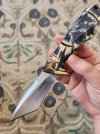So what you are saying is for a manufactured item like a knife there's no easy way for a customs agent to verify the species of origin short of destruction of the object. Does that sound accurate?
Maybe it's just me but it sounds like there's no convenient test for Customs Agents to employ.
Yes, for a manufactured item that is not cross cut and has both of the ends covered (e.g., by a bolster) it would be very difficult. Again, the guides that Fish & Wildlife use are geared more toward raw ivory. However, I have some barehead mammoth knives and there is enough thickness visible on the bare end to see the Schreger lines.
If the scales are cross cut, like the last one shown by Locutus D'Borg, it would be quite simple. And his other two mammoth knives are barehead, and if the scales are thick enough you would be able to see the Schreger lines. But for your knife it would be very difficult, and a small sample for carbon 14 testing would have to be taken from it. As long as you don't live in a state that bans mammoth, you would have no problem buying or selling mammoth. And in states where mammoth is not banned, knifemakers can import ivory from overseas and it would be checked by customs before being allowed into the country. Then the knifemaker would be free to use it for knives like yours. Since your knife was made after the 1989 CITES ban on elephant ivory trade, it was apparently used with mammoth that still made it into the country since then, legally I hope for the maker. The elephant ivory ban was strengthened in 2014 and 2016, but there is no federal ban on the importation of mammoth ivory. More info here:
Because of the poaching of African Elephants, many countries have banned the import of modern Ivory. Smugglers have been marking shipments of modern ivory as fossil ivory to get it past customs. Here in the United States, beginning with New Jersey and New York, state legislators have been...
www.aaps-journal.org
The bans are only for selling or buying, not possession, at least in my state (CA). Here is the wording in the CA law:
(b) Except as provided in subdivision (c), it is unlawful to
purchase, sell, offer for sale, possess with intent to sell, or
import with intent to sell ivory or rhinoceros horn.
And ivory is defined as:
(2) "Ivory" means a tooth or tusk from a species of elephant,
hippopotamus, mammoth, mastodon, walrus, warthog, whale, or narwhal,
or a piece thereof, whether raw ivory or worked ivory, and includes a
product containing, or advertised as containing, ivory.
Other states have different language, but most states do not currently ban the sale of mammoth.


